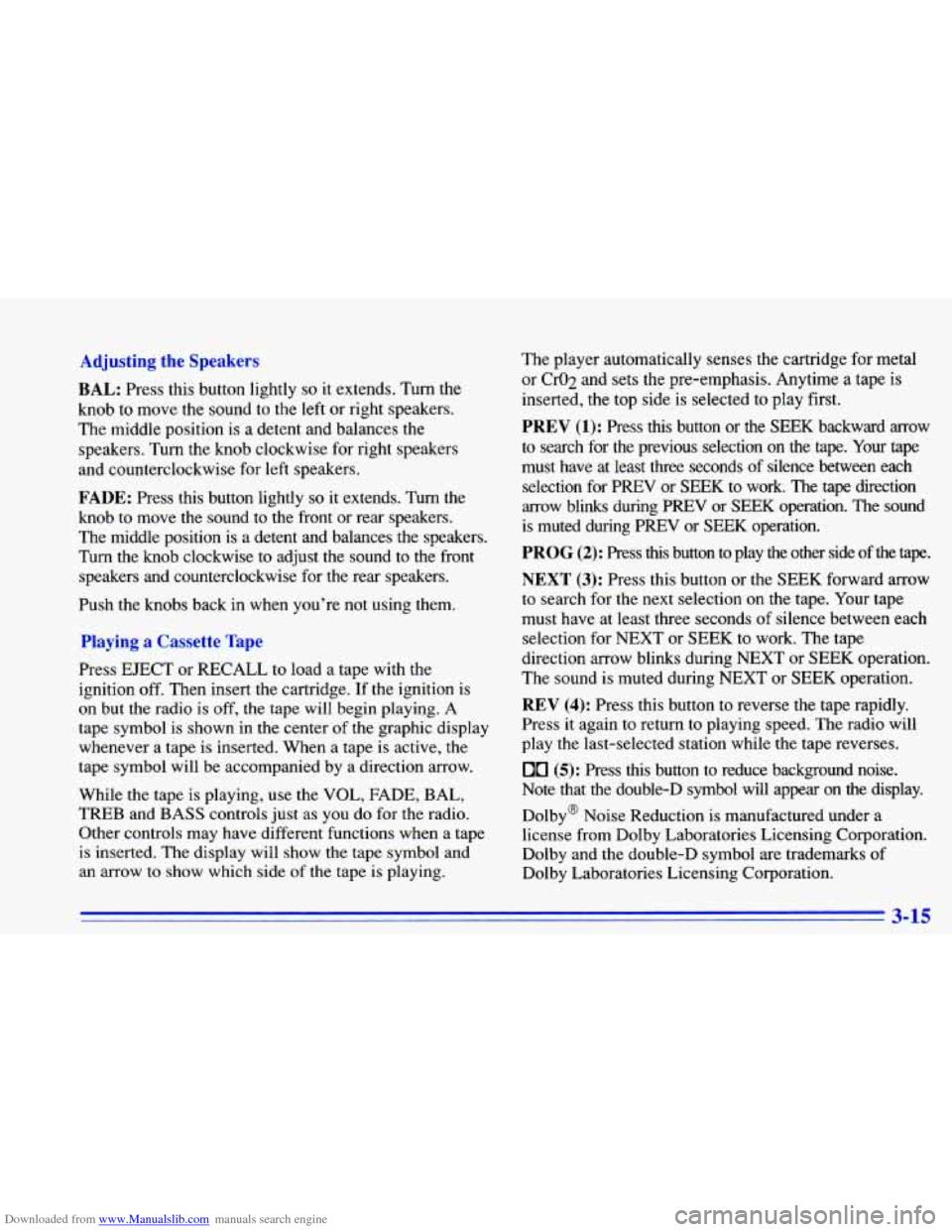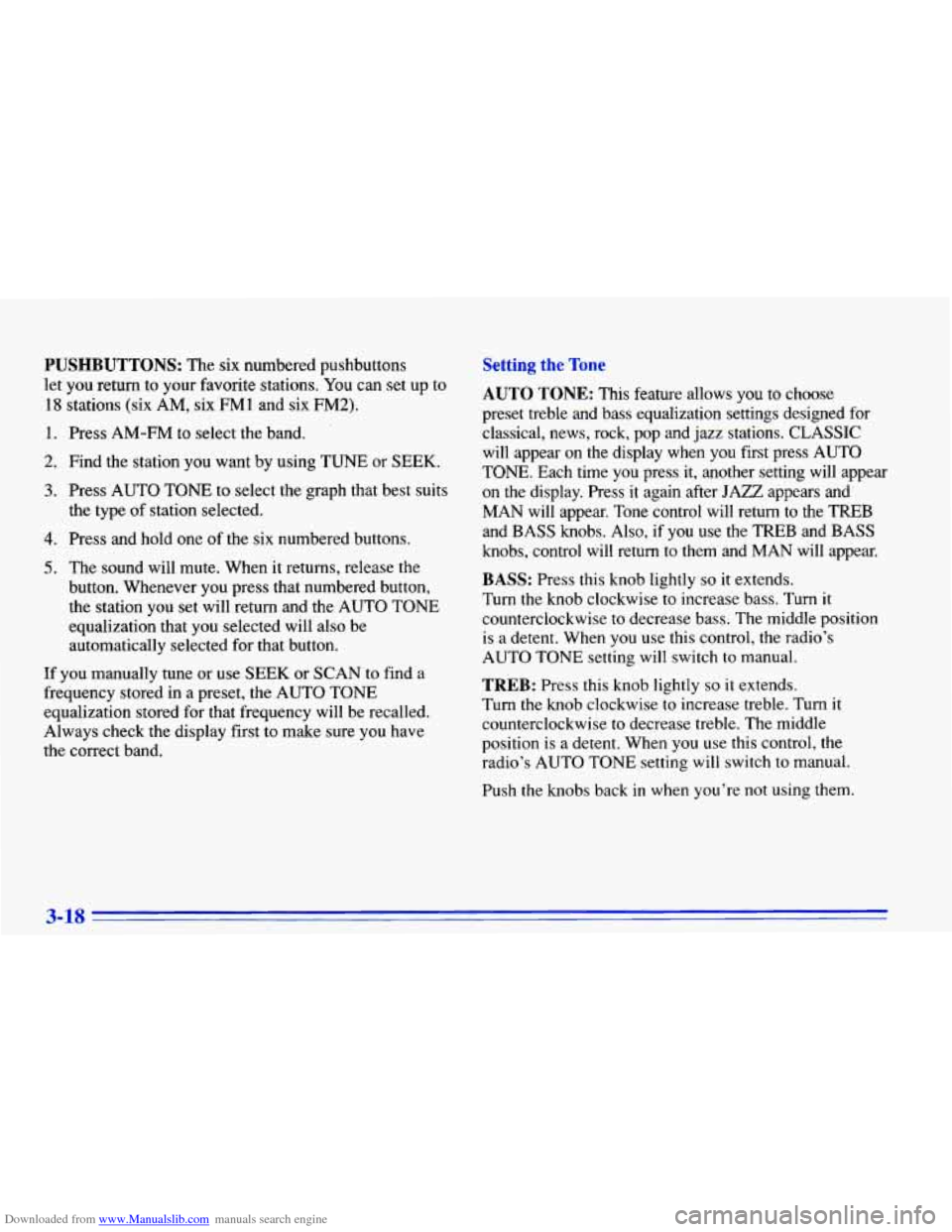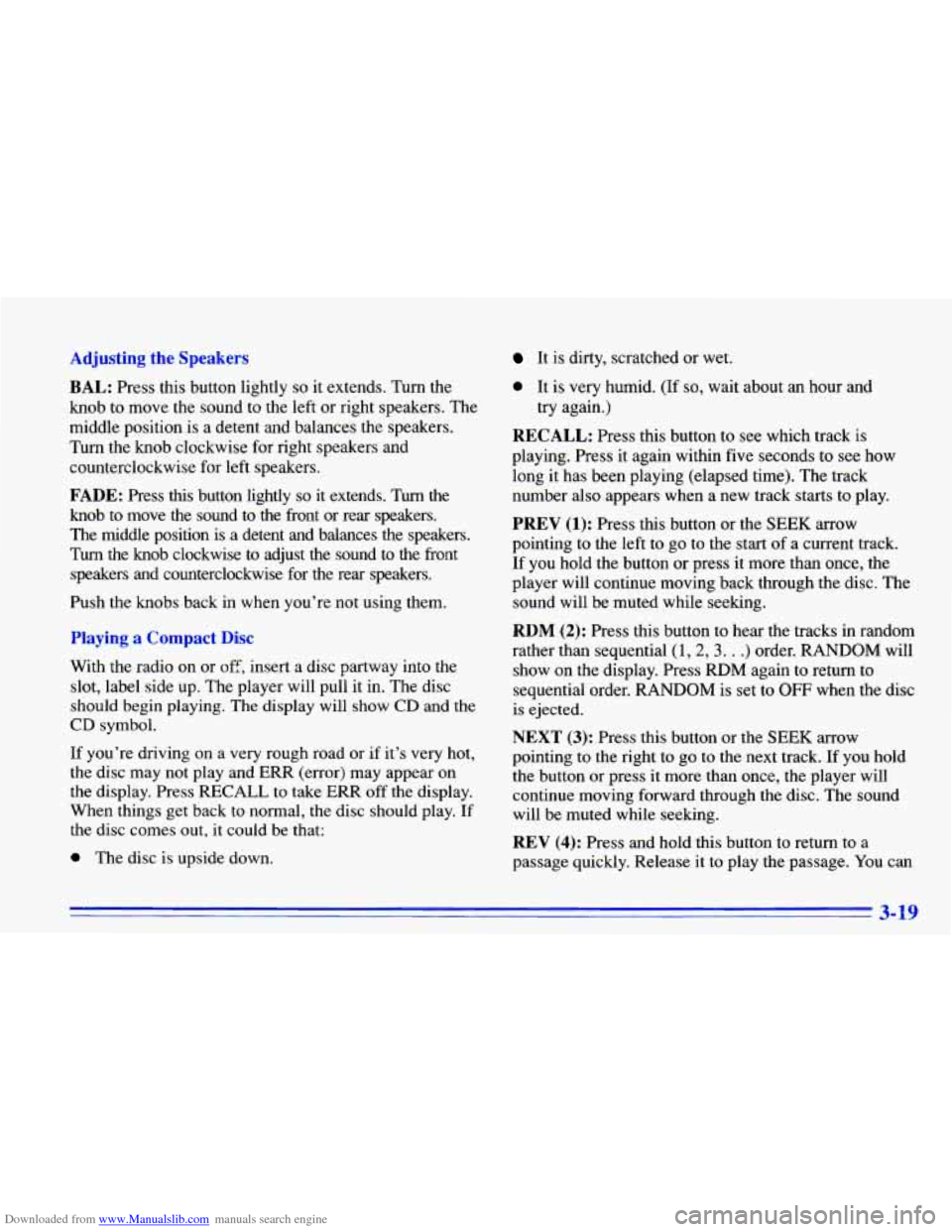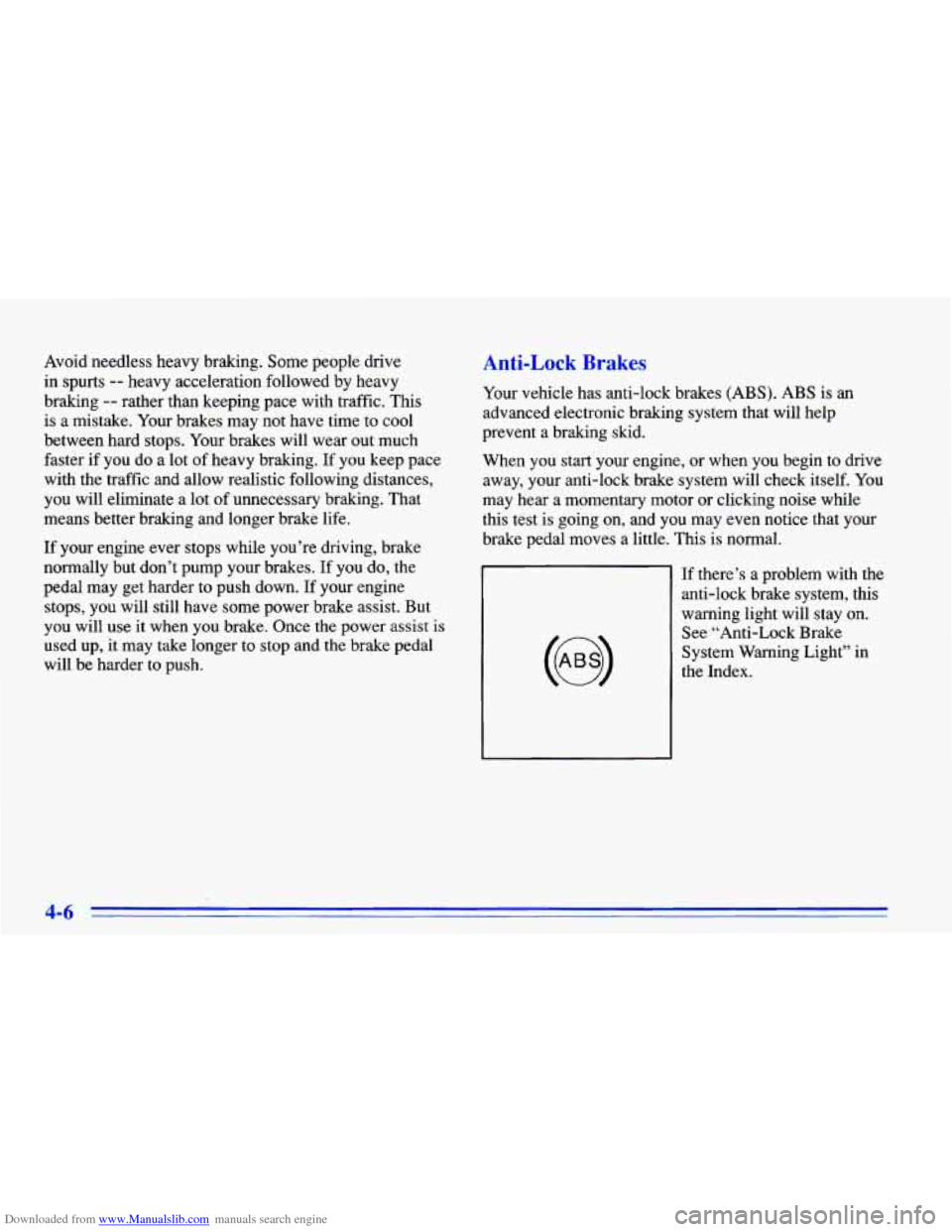1996 CHEVROLET CAVALIER light
[x] Cancel search: lightPage 151 of 372

Downloaded from www.Manualslib.com manuals search engine Adjusting the Speakers
BAL: Press this button lightly so it extends. Turn the
knob to move the sound to the left or right speakers.
The middle position
is a detent and balances the
speakers. Turn the knob clockwise for right speakers
and counterclockwise for left speakers.
FADE: Press this button lightly so it extends. Turn the
knob to move the sound to the front or rear speakers.
The middle position is a detent and balances the speakers.
Turn the knob clockwise to adjust the sound to the front speakers and counterclockwise for
the rear speakers.
Push the knobs back in when you’re not using them.
Playing a Cassette Tape
Press EJECT or RECALL to load a tape with the
ignition off. Then insert the cartridge. If the ignition is
on but the radio is
off, the tape will begin playing. A
tape symbol is shown in the center of the graphic display
whenever a tape is inserted. When a tape is active, the
tape symbol will be accompanied by a direction arrow.
While the tape is playing, use the VOL, FADE, BAL,
TREB and BASS controls just as you do for the radio.
Other controls may have different functions when a tape
is inserted. The display will show the tape symbol and
an arrow to show which side
of the tape is playing. The
player automatically senses the cartridge for metal
or CrO2 and sets the pre-emphasis. Anytime
a tape is
inserted,
the top side is selected to play first.
PREV (1): Press this button or the SEEK backward arrow
to search for the previous selection
on the tape. Your tape
must have at least three seconds of silence between each selection for PREV or SEEK to work. The
tape direction
arrow blinks during PREV or
SEEK operation. The sound
is muted during PREV or SEEK operation.
PROG (2): Press this button to play the other side of the tape.
NEXT (3): Press this button or the SEEK forward arrow
to search for the next selection on the tape. Your tape
must have at least three seconds of silence between each
selection
for NEXT or SEEK to work. The tape
direction arrow blinks during NEXT or
SEEK operation.
The sound is muted during NEXT or SEEK operation.
REV (4): Press this button to reverse the tape rapidly.
Press
it again to return to playing speed. The radio will
play the last-selected station while the tape reverses.
00 (5): Press this button to reduce background noise.
Note that the double-D symbol will appear on the display.
Dolby@ Noise Reduction is manufactured under a
license from Dolby Laboratories Licensing Corporation.
Dolby and the double-D symbol are trademarks of
Dolby Laboratories Licensing Corporation.
3-15
Page 153 of 372

Downloaded from www.Manualslib.com manuals search engine Playing the Radio
PWR: Press this knob to turn the system on and off.
VOL: Turn the upper knob clockwise to increase volume.
The faster the
VOL knob is rotated, the quicker the radio
goes
to maximum. Turn it counterclockwise to decrease
volume. The knob is capable of rotating continuously.
SCV Your system has a feature called
Speed-Compensated-Volume (SCV). With SCV, your
audio system adjusts to make up for road and wind noise
as you drive. The volume should always sound the same
level
to you as you drive. The control behind the upper
knob has SCV positions. The top position has a higher
maximum volume and gets louder faster than the middle
two positions. If you don’t want to use SCV, turn the
control all the way down.
AM-FM: Press this button to alternate between AM,
FMl and FM2. The display shows your selection.
RECALL: Press this button to recall the station being
played. If
you press the button when the ignition is off,
the clock will show for a few seconds.
TUNE: Press this knob lightly so it extends. Turn it to
choose radio stations. Push the knob back in when
you’re not using it.
SEEK: Press the forward or backward arrow to go to
the
next higher or lower station. The sound will be
muted while seeking.
SCAN: Press one of the SEEK arrows for two seconds,
and SCAN will appear on the display. Use SCAN
to
listen to stations for a few seconds. The radio will go to
a station, stop for
a few seconds, then go on to the next
station. Press SEEK again
to stop scanning. The sound
will be muted while scanning.
P.SCAN: Press this button to listen to each of your
favorite stations stored on your pushbuttons for a few
seconds.
The radio will scan through each of the stations
stored on your pushbuttons, except
those stations with
weak reception. The AUTO TONE setting stored for
that pushbutton will be automatically chosen. Press P.SCAN or one of the pushbuttons again to stop
scanning. P.SCAN will be displayed whenever the tuner
is in the P.SCAN mode. The channel number (Pl-P6)
will appear momentarily just before the frequency is
displayed. In FM mode, this function will scan through
both
FM 1 and FM2 preset stations and FM 1 or FM2 will
appear on
the display.
3-17
Page 154 of 372

Downloaded from www.Manualslib.com manuals search engine PUSHBUTTONS: The six numbered pushbuttons
let you
return to your favorite stations. You can set up to
18 stations (six AM, six FM1 and six FM2).
1. Press AM-FM to select the band.
2. Find the station you want by using TUNE or SEEK.
3. Press AUTO TONE to select the graph that best suits
4. Press and hold one of the six numbered buttons.
the
type of station selected.
5. The
sound will mute. When it returns, release the
button. Whenever you press that numbered button, the station you set will return and the AUTO TONE
equalization that you selected will also be
automatically selected for that button.
If 70 fnmually tune or use SEEK or SCAN to find a
frequency stored in a preset, the AUTO TONE
equalization stored for that frequency will be recalled.
Always check the display first to make sure you have
the correct band.
Setting the Tone
AUTO TONE: This feature allows you to choose
preset treble and bass equalization settings designed for
classical, news, rock, pop and jazz stations.
CLASSIC
will appear on the display when you first press AUTO
TONE. Each time you press
it, another setting will appear
on
the display. Press it again after JAZZ appears and
MAN will appear. Tone control will return
to the TFEB
and BASS knobs. Also, if you use the TREB and BASS
knobs, control will return to them and
MAN will appear.
BASS: Press this knob lightly so it extends.
Turn
the knob clockwise to increase bass. Turn it
counterclockwise to decrease bass. The middle position is a detent. When you use this control, the radio’s
AUTO
TONE setting will switch to manual.
TREB: Press this knob lightly so it extends.
Turn
the knob clockwise to increase treble. Turn it
counterclockwise to decrease treble. The middle
position is a detent. When you use this control, the
radio’s AUTO TONE setting
will switch to manual.
Push the knobs back
in when you’re not using them.
3-18
Page 155 of 372

Downloaded from www.Manualslib.com manuals search engine Adjusting the Speakers BAL:
Press this button lightly so it extends. Turn the
knob to move the sound to the left or right speakers. The
middle position is a detent and balances the speakers.
Turn the knob clockwise for right speakers and
counterclockwise for left speakers.
FADE: Press this button lightly so it extends. Turn the
knob to move the sound to the front or rear speakers.
The middle position is a detent and balances the speakers.
Turn the knob clockwise to adjust the sound to the front speakers and counterclockwise for the rear speakers.
Push the knobs back in when you’re not using them.
It is dirty, scratched or wet.
e It is very humid. (If so, wait about an hour and
RECALL: Press this button to see which track is
playing. Press it again within
five seconds to see how
long it has been playing (elapsed time). The track
number also appears when a new track starts to play.
PREV (1): Press this button or the SEEK arrow
pointing to the left to go to the start of a current track.
If you hold the button or press it more than once, the
player will continue moving back through the disc. The
sound will be muted while seeking. try again.)
Playing a Compact Disc
With the radio
on or off, insert a disc partway into the
slot, label side up. The player will pull it in. The disc
should begin playing. The display will show CD and the
CD symbol.
,If you’re driving on a very rough road or
if it’s very hot,
the disc may not play and ERR (error) may appear on
the display. Press RECALL
to take ERR off the display.
When things get back to normal, the disc should play.
If
the disc comes out, it could be that:
0 The disc is upside down.
RDM (2): Press this button to hear the tracks in random
rather than sequential
(1 , 2,3. . .) order. RANDOM will
show on the display. Press RDM again to return to
sequential order. RANDOM is set to
OFF when the disc
is ejected.
NEXT (3): Press this button or the SEEK arrow
pointing to the right to
go to the next track. If you hold
the button
or press it more than once, the player will
continue moving forward through the disc. The sound
will be muted while seeking.
REV (4): Press and hold this button to return to a
passage quickly. Release it to play the passage. You can
3-19
Page 160 of 372

Downloaded from www.Manualslib.com manuals search engine Care of Your Cassette Tape Player
A tape player that is not cleaned regularly can cause
reduced sound quality, ruined cassettes or a damaged
mechanism. Cassette tapes should be stored in their
cases away from contaminants, direct sunlight and
extreme heat. If they aren’t, they may not operate
properly or may cause failure of the tape player.
Your tape player should be cleaned regularly after every
50 hours of use. Your radio may display CLN to indicate
that you have used
your tape player for 50 hours without
resetting the tape clean timer.
If you notice a reduction in
sound quality, try a known good cassette to see if the tape
or the tape player is at fault. If this other cassette has n\
o
improvement
in sound quality, clean the tape player.
Cleaning may be done with a scrubbing action,
non-abrasive cleaning cassette with pads which scrub
the tape head as the hubs
of the cleaner cassette turn.
It is normal for the cassette to eject while cleaning
because your unit is equipped with a cut tape feature.
To temporarily override this feature (for one insertion),
turn the radio
off and press and hold TAPE AUX until
the tape symbol flashes on the display, then insert the
cassette again. Insert the cassette at least three times to
ensure thorough cleaning. A scrubbing action cleaning cassette is available through your Chevrolet dealer.
You may also choose a non-scrubbing action, wet-type
cleaner which uses a cassette with
a fabric belt to clean the
tape head. This type of cleaning cassette will not eject. It
may not clean as thoroughly as the scrubbing
type cleaner.
Cassettes are subject to wear and the sound quality may
degrade over time. Always make sure that the cassette
tape is in good condition before you have your tape
player serviced.
Care of Your Compact Discs
Handle discs carefully. Store them in their original cases
or other protective cases and away from direct sunlight
and dust.
If the surface of a disc is soiled, dampen a
clean, soft cloth in a mild, neutral detergent solution and
clean it, wiping from the center to the edge.
Be sure never to touch the signal surface when handling
discs. Pick
up discs by grasping the outer edges or the
edge of the hole and the outer edge.
Fixed Mast Antenna
The fixed mast antenna can withstand most car washes
without being damaged.
If the mast should ever become
slightly bent, you can straighten it out by hand.
If the
mast is badly bent, as
it might be by vandals, you should
replace
it.
Check every once in a while to be sure the mast is still
tightened to the fender.
3-24
Page 168 of 372

Downloaded from www.Manualslib.com manuals search engine Avoid needless heavy braking. Some people drive
in spurts
-- heavy acceleration followed by heavy
braking
-- rather than keeping pace with traffic. This
is a mistake. Your brakes may not have time to cool
between hard stops. Your brakes will wear out much
faster if you do a lot of heavy braking. If you keep pace
with the traffic and allow realistic following distances,
you will eliminate a lot of unnecessary braking. That means better braking and longer brake life.
If your engine ever stops while you’re driving, brake
normally
but don’t pump your brakes. If you do, the
pedal may get harder to push down. If your engine
stops, you will still have some power brake assist. But
you will use it when you brake. Once the power assist
is
used up, it may take longer to stop and the brake pedal
will be harder to push,
Anti-Lock Brakes
Your vehicle has anti-lock brakes (ABS). ABS is an
advanced electronic braking system that will help
prevent a braking skid.
When you start your engine, or when you begin to drive
away, your anti-lock brake system will check itself. You
may hear a momentary motor or clicking noise while
this test is going on, and you may even notice that your
brake pedal moves a little. This is normal.
If there’s a problem with the anti-lock brake system, this
warning light will stay
on.
See “Anti-Lock Brake
System Warning Light” in
the Index.
4-6
Page 170 of 372

Downloaded from www.Manualslib.com manuals search engine Remember: Anti-lock doesn’t change the time you need
to get your foot up to the brake pedal or always decrease
stopping distance. If you get too close to the vehicle in
front of you, you won’t have time to apply your brakes
if that vehicle suddenly slows or stops. Always leave
enough room up ahead to stop, even though you have
anti-lock brakes.
Using Anti-Lock
Don’t pump the brakes. Just hold the brake pedal
down and let anti-lock work for you. You may feel
the
system working, or you may notice some noise, but this
is normal.
Enhanced Traction System
If your vehicle has the optional four-speed automatic
transaxle, it also has an Enhanced Traction System
(ETS) that limits wheel spin. This is especially useful
in slippery road conditions. The system operates only
when the transaxle shift lever is in the
THIRD (3) or
OVERDRIVE
(a) position and the system senses
that one or both of the front wheels are spinning or
beginning to lose traction. When this happens, the system reduces engine power and may also upshift the
transaxle to limit wheel spin.
LOW
TRAC
This light will come on
when your Enhanced
Traction System is limiting
wheel spin. See “Enhanced
Traction System Active
Light” in the Index.
You
may feel or hear the system working, but this
is normal.
4-8
Page 171 of 372

Downloaded from www.Manualslib.com manuals search engine ETS
OFF
When the transaxle shift
lever
is in the THIRD (3) or
OVERDRIVE
(Q) position
and the parking brake is
fully released, this warning
light will come on to let you
know if there’s a problem
with the system.
See “Enhanced Traction System Warning Light” in the
Index. When this warning light is on, the system will not
limit wheel spin. Adjust your driving accordingly.
The Enhanced Traction System can operate only
when the transaxle shift lever is in the THIRD
(3) or
OVERDRIVE
(a) position. To limit wheel spin,
especially in slippery road conditions, you should use
the other shift lever positions only when necessary.
See
“Automatic Transaxle” in the Index. (If your vehicle
ever gets stuck in sand, mud, ice or snow, see “Rocking
Your Vehicle” in the Index.) When you move the shift lever
to a position other than
THIRD
(3) or OVERDRIVE (@), the system will turn
off. The Enhanced Traction System warning light will
come on and stay on. If the Enhanced Traction System is
limiting wheel spin when you move the shift lever to
another position, the system won’t turn off right away. It
will wait until there’s no longer a current need to limit
wheel spin.
You can turn the system back on at any time by
moving the shift lever back to the THIRD
(3) or
OVERDRIVE
(@) position again. The Enhanced
Traction System warning light should go off.
Braking in Emergencies
Use your anti-lock braking system when you need to.
With anti-lock, you can steer and brake at the same
time. In many emergencies, steering can help you more
than even the very best braking.
Steering
Power Steering
If you lose power steering assist because the engine
stops or the system is not functioning, you can steer but
it will take much more effort.
4-9